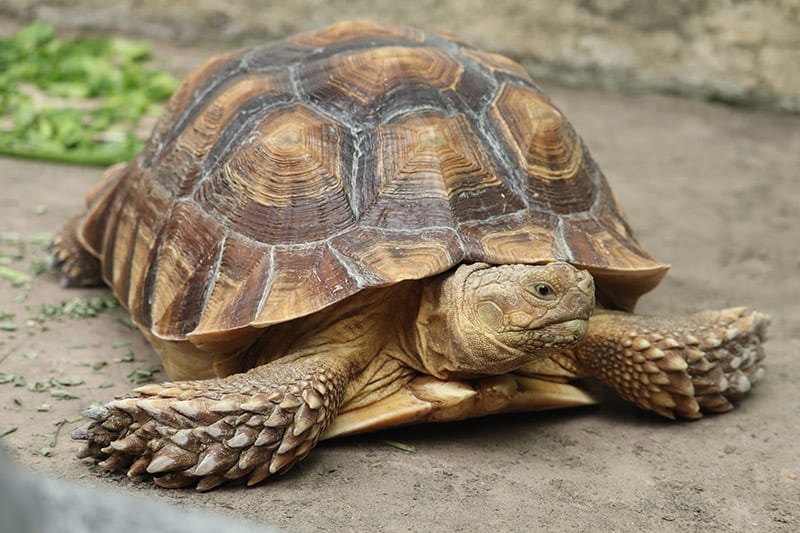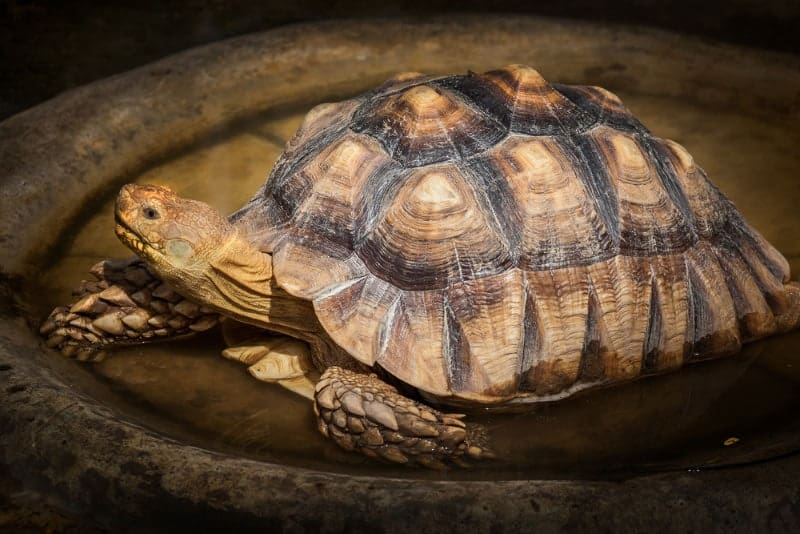Animal-World’s Featured Pet for this week is: The Sulcata Tortoise!
Has it always been your dream to have a gigantic tortoise? I’m guessing not! But just in case it is, the Sulcata Tortoise may be right up your alley! The pet store I worked at sold a couple of these guys, but it was usually only on special order. We didn’t normally keep them in the store on a regular basis. People who purchase these tortoises usually do so because they are very intrigued by their size as well as their many great pet qualities!
About the Sulcata Tortoise
I bet your first question is: Just how big do these guys get? Well, the males often reach 2 and a half feet in length and can weigh up to 150 pounds! Females come a little smaller than males, reaching a little under 2 feet in length and weighing up to 75 pounds. These are big tortoises! Without regard for its size, the Sulcata Tortoise has many attributes which make keeping it as a pet appealing. They are very tame, have good dispositions, are friendly, and don’t get sick easily.
The Sulcata TortoiseGeochelone sulcata, also called the African Spurred Tortoise, is the third largest tortoise in the world, coming in behind only the tortoises from the Galapagos and the Aldabras. The natural habitat of these huge tortoises consists of hot temperatures and dry scrubland areas where they can make deep burrows and have plenty of plants to eat. North-Central Africa is their native continent, just south of the Sahara Desert. There is cause to worry about them as they are listed as Vulnerable on the IUCN Red List of Threatened Species. It is rare to find one in the wild now, as well.

Caring For Your Sulcata Tortoise
Before acquiring a Sulcata Tortoise, you will want to be fully prepared. You can get one as a baby, but these guys grow fast! Make sure you have a large area or terrarium for them as they grow to their full size. If you keep them outside, you should also provide some sort of enclosure where they can go to get out of the elements. Provide them with heat lamps and different props and shelters to make them feel more comfortable and at home. These can be things such as logs, huge leaves and piles of straw. A good substrate is a sand and peat moss mixture (mostly sand). Because these tortoises come from a very dry part of the world, they do not tolerate humidity and dampness at all. DO NOT keep them outdoors if you live in a humid area. This can lead to all sorts of illnesses and conditions.
Feeding a Sulcata Tortoise can also be a chore! They can eat a lot, and they need a varied diet! Provide them with a whole mixture of different greens everyday, as well as such things as hay, dandelions, and grass. If you can get your hands on Opuntia cactus pads, these are also very good for them. This will provide them with a high fiber diet, which is crucial to their health. Sprinkle their food with a calcium powder a couple times a week as well. If you wish to give treats, only do so a couple times a month. Good, healthy treats could include apples or melons. Clean out uneaten food at the end of each day. Provide fresh water daily in a large flat dish.

Problems and Availability of the Sulcata Tortoise
The most common problems you will run into with this tortoise are respiratory illnesses. These almost always occurs due to improper keeping. If they are not kept in hot and dry environments they will inevitably become sick. Watch out for runny noses and eyes. Renal problems can also arise if they are not fed a high-fiber and nutritionally sound diet. So make sure they get their greens!
If you would like to acquire a Sulcata Tortoise, your best bet is a reptile store, online from reputable breeders, or a reptile show. The vast majority of specimens sold in the United States are captive-bred babies and are readily available when you look in the right place.
Isn’t the idea of keeping such a large tortoise fascinating? Do you have any stories of your own that you’d like to share? We would love to hear it!
Jasmine is a team member at Animal-World and has contributed many articles and write-ups.
Featured Image Credit: apple2499, Shutterstock
